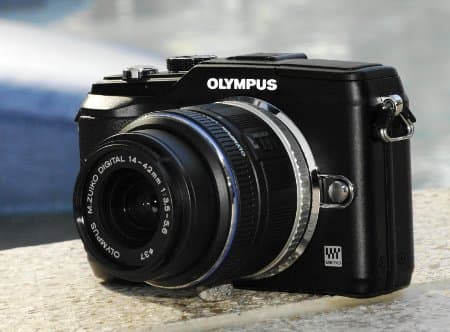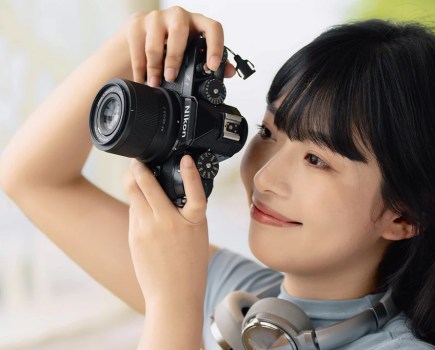Olympus E PL2 first look
Olympus E-PL2 review: first impressions
 The E-PL1 was Olympus’s first entry-level Micro System Camera and yet it featured quite an advanced feature set. The Olympus E-PL2 builds on this and though on first glance the differences between the two appear slight, the camera has been refined to give it a classier feel than its predecessor. It features the same 12.3MP Live MOS sensor as we have seen in previous models and the same TruePic V engine. The 324 zone multi metering system also remains, while the sensitivity range has been extended to ISO 6400 from a previous high of ISO 3200.
The E-PL1 was Olympus’s first entry-level Micro System Camera and yet it featured quite an advanced feature set. The Olympus E-PL2 builds on this and though on first glance the differences between the two appear slight, the camera has been refined to give it a classier feel than its predecessor. It features the same 12.3MP Live MOS sensor as we have seen in previous models and the same TruePic V engine. The 324 zone multi metering system also remains, while the sensitivity range has been extended to ISO 6400 from a previous high of ISO 3200.
The most noticeable change to the Olympus E-PL2 though is not in the body at all, but in the new version of the 14-42mm kit lens. The lens is physically smaller and lighter, making the 742g combination of lens and camera one of the lightest compact system cameras currently on the market. Zoom and focus rings operate more smoothly, and the catch to take the lens in and out of its stowed position now only needs to be held in when putting the lens away – a change that comes as a result of user feedback. This makes the start-up process a little quicker. The focusing function of the lens is now silent too, which means uninterrupted sound when shooting video.

In addition to the new kit lens, Olympus has introduced a series of lens adapters to the Olympus E-PL2. These allow you to increase your creativity without the outlay of a whole new lens. The adapters include a wide-angle, fish eye and macro models with prices starting from around £60.
Olympus E PL2 handling
Olympus E-PL2 handling

The body is still on the large side, but it feels more solid thanks to the new matte finish (our sample was finished in black) and textured grip. Like the E-PL1, it offers an accessory port under the hotshoe so, although there is no viewfinder in the camera, you can attach the electronic viewfinder that was seen with the E-P2.
The back of the camera has had the largest overhaul however; gone are the brash square buttons, replaced more subtle rounded ones and a new rotating d-pad control in keeping with the higher Pen models. The screen is also now a larger 3in display with 460k dot resolution.
Art filters have been updated to Art Filters II, with the addition of the dramatic tone filter, as seen in the E-5. However, these art filters cannot be used with manual or priority exposure modes – as they sit as a shooting mode on the dial. The filters do though, allow you to combine effects of more than one filter, and also select variations on some of the filters – Pin Hole for instance, has a choice of three versions, and grainy film has two levels of contrast available. Another addition to this is an Art frame option that allows a virtual border to be added to each art filter during the processing. These effects can all be used in the video capture as well as with still images. Though the results of the art filters are now much quicker to review after taking the shot, the background processing and writing locks the camera down for a considerable amount of time.
The face detection has been extended to offer more accurate focusing when taking close up faces. This uses what Olympus is calling ?eye detection?, to focus on the eyes to ensure optimal focusing. There is also the addition of a multi exposure mode that can combine up to three raw images.
Olympus has also introduced an adaptor called Pen Pal, which sits in the hotshoe. Together with an application for android phones, users of the E-PL2 can send images directly to their phone via Bluetooth for sharing and uploading to social networking sites. There is also a new MAL-1 Macro arm light, that uses two flexible metal arms with light sources on the ends, powered by the camera for close up work.
Olympus E PL2 image quality
Olympus E-PL2 image quality

Images from the Olympus E-PL2 taken so far seem bright and punchy with no obvious issues. Noise is still obvious at higher ISOs but not until beyond the ISO 1600 mark and the results actually look better on the computer screen than they do on the back of the camera. Only once we test the camera fully can we comment in any depth on whether this is an improvement over the E-PL1, but the images certainly look respectable at first glance.
The art filters are one of this camera’s strengths, as they are fun to use and give some very pleasing results, especially the likes of the Dramatic Tone and Pin Hole modes. In many ways, the Olympus E-PL2 is the camera the E-PL1 should have been and I think that this should stand up to the entry level compact system camera competition. The E-PL2 will be available this month, priced around £500.








